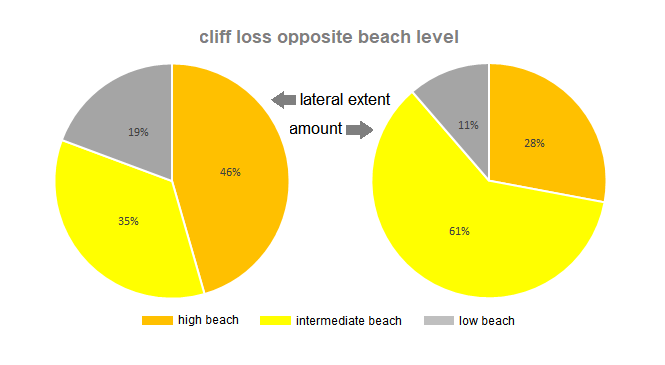background (links)
Beach levels, measured as contours, are taken as those at and around the foot of the cliff at the time of survey. A high or full upper beach lies above a minimum 2.5 metres OD (Ordnance Datum), a low or thin beach below a maximum 1.5 metres OD. An intermediate beach occupies the range between the two. The senses of full and thin relate to depth of, or sometimes in the case of the latter an absence of, a sediment layer on an underlying clay platform.

Over half the coastal length displays a high beach. The extent of high beach has tended to increase and that of low beach reduce over the period 2008 to 2024, though this is not necessarily indicative of more sediment being available (see below at effects of sea level rise).
Throughout the same period, the trend in the annual rate of cliff loss for the undefended coast shows a slight rise albeit with much annual variation.

Data from the previous system of cliff loss monitoring, using erosion posts (EPs), produces a distinct upward trend over a longer term, again with pronounced variation.

The chart displays one trace assembled from 55 locations for which records are complete or very nearly so, and another trace that represents all 120 EPs as modelled from information that exists. A difference in formulation of irregular survey dates causes brief misalignment around 1991 to 1993.

A full upper beach offers some protection against wave energy. In quieter weather, high tide often does not reach the foot of the cliff.
Laterally (along the coast), a little over one half of cliff loss occurs where the beach is less than full. Cliff recession where beach is high might be lag resulting from direct and delayed erosion.
In terms of volume of material, just over three-quarters of loss is opposite a beach less than full.
(The above pie charts are based on data from 2008 to 2022.)
effects of sea level rise (SLR)
Although data specific to the East Yorkshire coast are not available, average mean sea level, relative to any land movement, is rising all around the UK, and the rate of change is increasing. The following chart provides a general perspective.

[State of the UK Climate 2020, M. Kendon, M. McCarthy, S. Jevrejeva, A. Matthews, T. Spark, and J. Garforth, International Journal of Climatology, Special Issue Article, published July 2021 (Section 6).]
However, the sea may be no deeper at the cliff base. According to the Bruun Rule, named after Per Bruun, a Danish-American coastal engineer, the cross-beach sediment profile tends to respond to sea level rise by adjusting to the former relationship. A state of equilibrium is maintained, with the beach shifting landward and very slightly upwards as the cliff erodes.

If sea level were to remain constant, the land-cliff-beach profile would shift horizontally landward as the cliff line recedes. Beach level at point A, the cliff foot at an earlier position, would drop for the later position. An example is shown at the page for Hollym, where the once buried Withernsea sewage outfall pipe became exposed. At Barmston, the seaward end of the outfall casing was undermined as the beach profile level shifted landward.
On each rise in sea level, the overall profile is maintained but is lifted as it moves landward (scale in the figure is exaggerated for emphasis). At point B, beach level is higher in respect to datum and the sea reaches further up the cliff face while the relation between components remains the same (i.e. in equilibrium). Sediment enabling the rise in beach level comes from eroded cliff material. Presented in its simplest form, the Bruun Rule proposes that the two quantities are equal.
In the case of the East Yorkshire coast, any effects of sea level rise on the beach profile at a particular location are tiny compared to those brought about by annual variation and sediment migration. For the coast as a whole, though, and over a time scale, some influence may be discerned.
As seen in the Beach Level Contours chart above, the spread of high beach is on the increase, and low beach on the decrease. This would indicate a small rise in beach level commensurate with sea level rise, in a manner suggested by the Bruun Rule. Eventually, since Ordnance Datum is a fixed level, the minimum and maximum parameters for deciding high and low beach will need to be revised.
Theoretically, sea contact with the land is made fractionally higher up the cliff but, as the water is no deeper at the cliff base because of a corresponding rise in beach level, this itself has limited direct impact on the rate of recession.
On the other hand, there is an increased threat of overtopping and flooding in lower lying areas when sea levels rise. It may be argued, too, that a higher mean level across the North Sea basin has implications for factors such as wave characteristics, and storm energy, which contribute to coastal erosion.
data for this page (spreadsheet)
program output (text file)
top
Page prepared by Brian Williams in August 2020. Last change November 2025.


